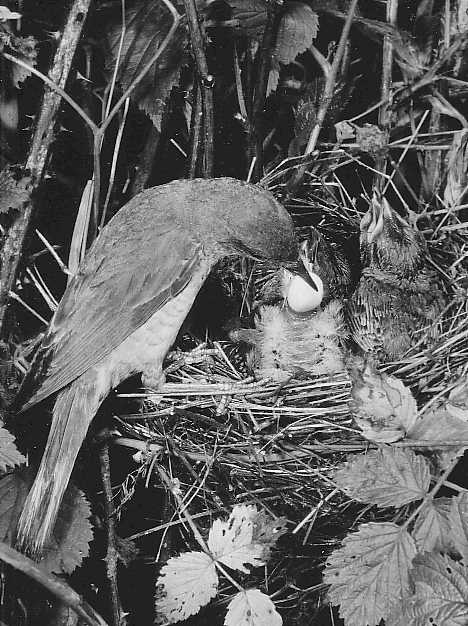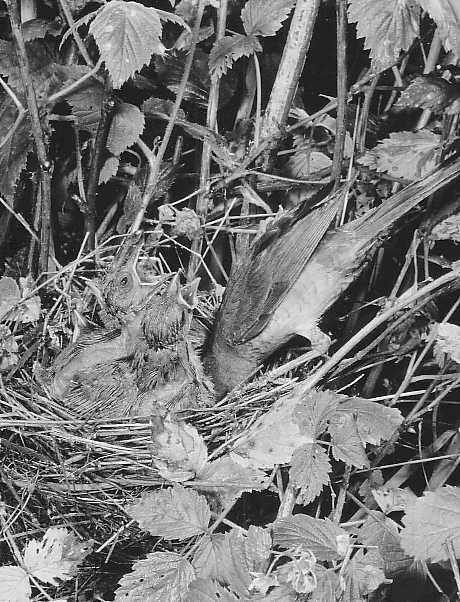The breeding of a pair of Golden Plovers of the Northern type Mr. Swanberg's photographs taken in Swedish Lapland, in a valley south of Svaipa (latitude 66° 16'), show breeding examples of the Northern race (Pluvialis apricaria albifrons) in its most pronounced form, having in the male an intensely black face and breast bordered by a conspicuous and sharply defined band of pure white. The female shows the typically dingier face pattern of that sex.
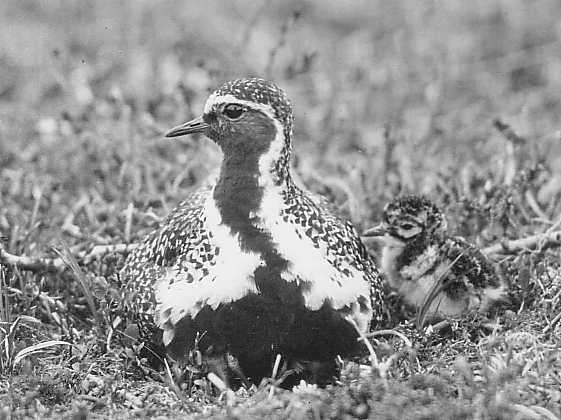
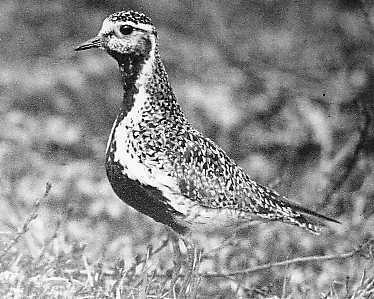
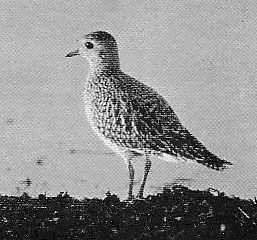

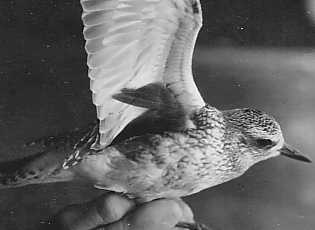
Eremophila Alpestris
We are once again indebted to Mr. Swanberg for a series of plates, this time of the Shore - Lark (Eremophila alpestris). The pictures were all taken on a field near Svaipa in Swedish Lapland (Lat. 66°10'N.) and show very well the bare stony nature of the nesting ground. Mr. Swanberg states that on the breeding grounds the species is "astonishingly watchful and cautious" and the nest is therefore difficult to find.
As a winter visitor to Britain the Shore - Lark has a very restricted distribution The Handbook describes it as an "annual autumn to spring visitor E coast from Yorkshire to Kent. Along S. coast occational elsewhere very rare. Over a fairly long period records would, no doubt, be found to conform generally to this picture, but over a short period such as the post - war years, it would appear that only im E Anglia has this species been a regular annual visitor.
The fact that some wintered in north Kent in 1948 - 49 was considered an unusual event (antea, vol. xliii, p. 116). In that winter, however, they seem to have been more widespread than usual : three were recorded in, Sussex in the autumn of 1948 (Sussex Bird Report, 1948 p.6) ; a party, of eight wintered at Gibraltar Point, Lincs. (Gibraltar Point Bird Obs., 1949, p. 16) ; there were several in Northumberland including a party which reached 21 at its maximum seen on various dates from October, 1948, to April, 1949 (Orn Rep. for Northumberland and Durham 1948, P. 118 1949, p.112) and one at the Isle of May on October 30th 1948 (Scot Nat., 62: 99). In Yorkshire (Y.N. U., Committee for Ornithology 1948, P. 57, 1949, p. 8) there were several at Kilnsea Spurn, the maximum being 29 in November, 1948 ; this party winterd and some birds were beginning to display by March 19th 1949. It is to be noted that Mr. Chislett (loc. cit.) says of these records : "Authenticated records of the Shore - Lark of recent years in Yorkshire have been extremely few. I know of only three records in the past ten years." All this suggests that in certain parts of its winter range in Britain this species is a visitor only in favourable years. There is some evidence that the current winter, 1951 - 52 may be a good year. We should be interested to hear whether readers, have found it so. Inland occurrences are very rare. It was recorded in Nottinghamshire in 1945 ; a second record for the same county (Report on the Birds of Nottinghamshire, 1946 - 1949 p.11) is placed in square brackets as the bird was only heard in flight with Sky - Larks; it may be significant, however, that the date of this occurrence was January 30th, 1949. J.D.W.
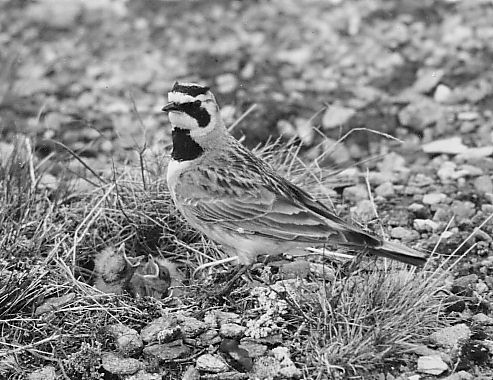
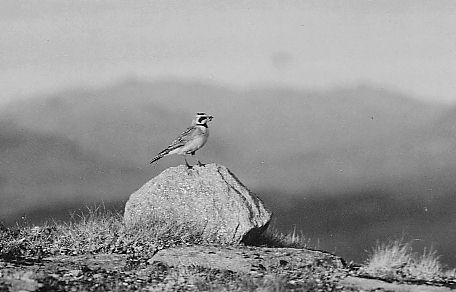
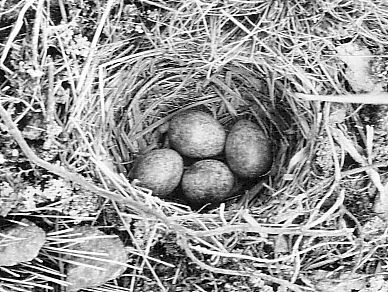
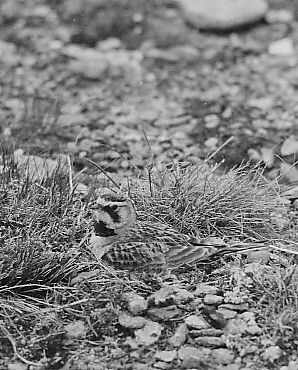

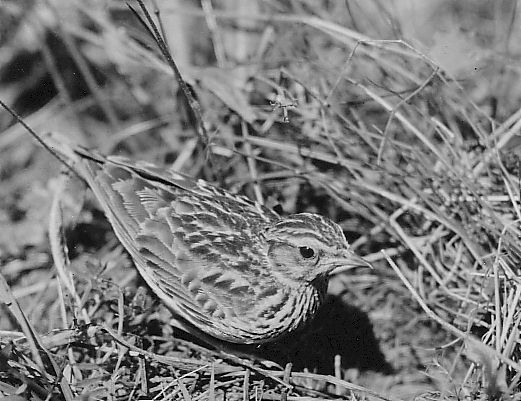
Lullula arborea
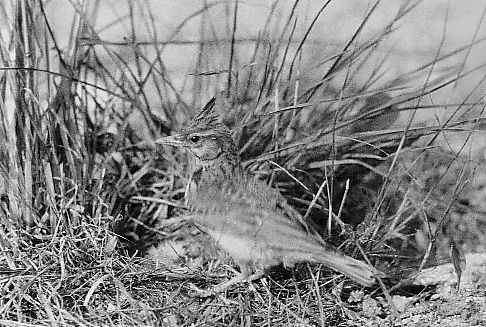
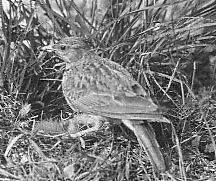

As a winter visitor the Snow-Bunting (Plectrophenax nivalis) is mainly a coastal bird. As a rule it occurs in some numbers on the north and east coasts, but in most years smaller numbers are also seen in the west and south-west, so that its winter distribution is a good deal wider than that of the Shore-Lark (Eremophila alpestris). Inland occurrences are somewhat uncommon, but in recent years several have been recorded at reservoirs and sewage farms in midland and lowland counties, including the London area. More normal winter haunts are the high moorlands of the Pennines, where they feed on the Purple Moor Grass (Molinia caerulea) and the gall-midge larvae which infest it, and the mountains of North Wales and the Lake District. Winter birds in the plumage are often quite inconspicuous on the ground, the females especially showing relatively little white, but the impression of dull coloration is soon dispelled when the birds take to flight as all show some white in the wing, males a good deal more than females. As with the Lapland Bunting (Calcarius lapponica) the Snow-Bunting's normal gait is a quick run.
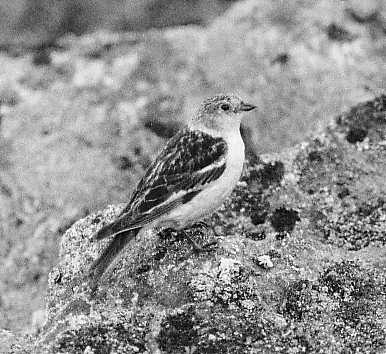 Female
Female
 Male
Male
Snösparv Snow Buntle
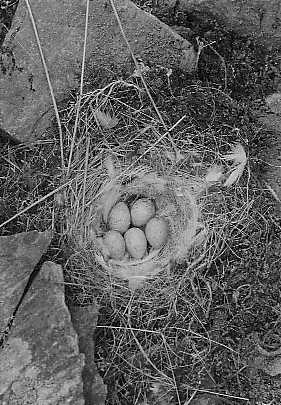 Nest
Nest
The male Barred Warbler is a uniform ash-grey above, the female a browner grey, both being darker and browner on the wings. All these plates give a good idea of the characteristically marked under-parts from which the bird gets its name, but plate 49 perhaps does so better than any other: the ground-colour below is whitish, but in summer both sexes are strikingly marked (except an the centre of the breast and belly) with crescent-shaped barrings, heavier and closer together on the sides of the breast, lighter on the flanks; the female is usually less distinctly marked than the male. Unfortunately, this barring is often of little use as a field-character in this country, because the majority of the birds recorded are immatures, which are more buff below and have little or no barring (except perhaps some at the sides of the breast and flanks), while the adults, by then in winter plumage, have the barring only on the sides. Another striking character of this bird, which shows up well, is the staring yellow eye, quite unlike that of any other British-recorded species except perhaps the Orphean Warbler (Sylvia hortensis), which has a paler yellow, almost white, iris; again, however, this is of no assistance in the identification of the immature bird which has a dark greyish-brown iris. The young Orphean and the Garden Warbler (S. borin) are probably the species which the Barred Warbler most resembles, but it is much more noticeably long-tailed than either, it lacks the rounded head of both, and is at the same time generally greyer in colour and heavier in appearance, with noticeably stout legs and bill, while pale tips to the primaries and secondaries show up in flight. The adult Barred Warbler in fresh plumage often has pale tips to the wing-coverts as well (to a very variable extent), thus forming two irregular whitish bars, but as can be seen in the worn-plumaged bird that appears in these photographs, these can easily be lost through abrasion.
The Barred Warbler is a rather skulking bird of hedges, thorns and brambles, building its nest chiefly in such places between a foot above the ground and head height. The nest is typical of the genus, a little untidily constructed of grasses and bents, lined with finer grasses, hair and rootlets. The eggs, usually five in number though the clutch varies from 3 to 6, are, however, rather characteristic, being faintly speckled with grey on a grey ground. Though the bird is usually secretive, it often delivers its not unattractive song, rather like that of the Garden Warbler though shorter and quicker, from a conspicuous perch or in a dancing, Whitethroat-like song-flight.
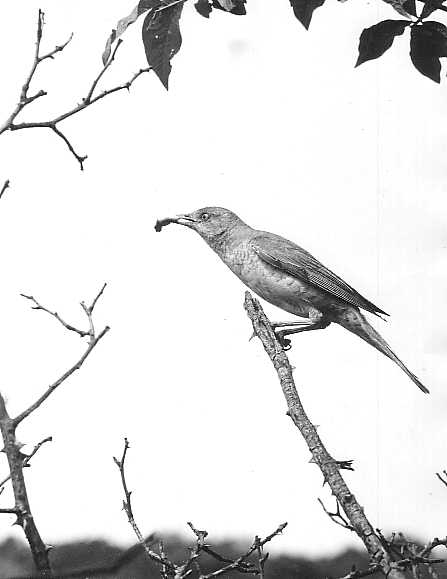
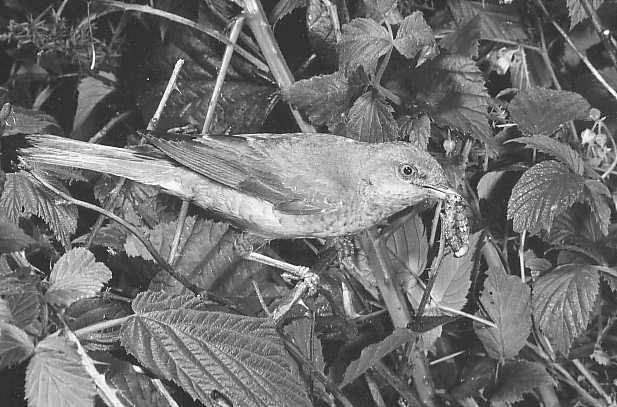
 3
3
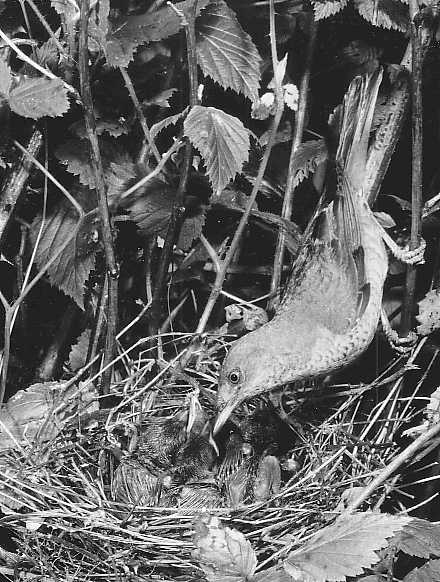
 4
4
